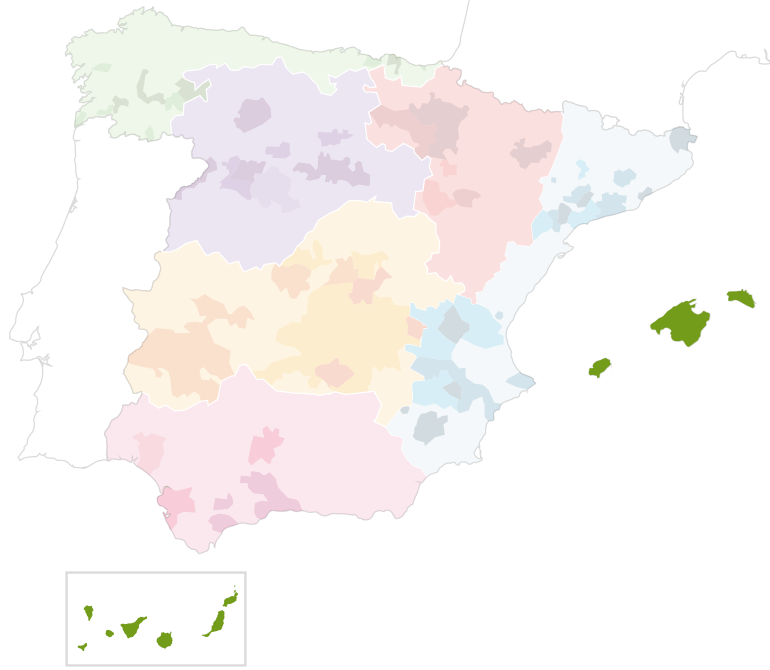You are here

The Islands
The Balearics—The islands of Mallorca and Minorca offer an increasing number of small production wines from indigenous and international grape varieties; they’re good wines, but only a handful are now available in the international market.
The Canaries—Though far away and off the coast of Africa, the Canaries are part of Spain and part of Spanish (and American) history. The Canaries were an important port on the long voyage to America, and it was from here that Columbus took sugarcane to transplant into the Americas to create rum.
Binissalem was the first of the Balearic Island’s Denominations of Origin to be granted this status in 1990. It takes its name from the growing area’s largest town, located at the centre of the island of Mallorca.
The wines from this area have distinctive character and remarkable quality thanks to the native grape varieties from which they are made, although today modern wines blended with recently planted varieties from abroad are also successful.
The DO is named after one of the island's districts (comarcas) and, in Mallorquí, it means 'plain and east coast' . The DO's regulation was published in spring 1999.
The vineyards lie in the flat, chalky central and eastern areas of the island, which offer optimum soil conditions.
Abona is the newest of Tenerife's four DO zones which, effectively, cover the island. Established in 1996, its young white, red and rosé wines were quickly supported by the ready-made market supplied by year-round tourism.
The vineyard area is growing rapidly in size, although it will not come into full production for some years.
El Hierro, the westernmost and smallest of the Canary Islands, has a long winemaking tradition.
Phylloxera never got a foothold in the Canary Island vineyards, so many of the older varieties, such as Vijariego and Bermejuelo, still survive . These are planted ungrafted to preserve all their natural richness.
The DO Gran Canaria, as it is today, was established in 2005, after a proccess to join the former DOs Monte Lentiscal (established in 1999) and Gran Canaria (established in 2000).
Some of the best white wines in Gran Canaria have come from high-altitude wineries in the centre of the island where the grapes are exposed to huge temperature differences over a long period of time.
This DO covers all the territory of the Canary Islands that have now more than 80 identified varieties of vines and preserve an extraordinary vine heritage, principally endemic.
It is one of the 4 world regions completely exempt from the phylloxera plague. The reason for this immunity is unknown, but this insect has never been detected in any of the Islands. As a consequence, the whole vineyard isungrafted, enabling a plant-soil total interaction, what may explain the strong mineralization of the Canary Islands wines.
DO La Gomera ( approved by the Ministry of Agriculture in 2009) is made up of fifteen bodegas which boast a total vineyard surface-area of 120 hectares. Most of the vineyards are located in the island regions known locally as the ‘medianías altas’: Las Hayas, Arure, El Cercado, Igualero, Los Aceviños, Alajeró, Las Hayas; and the ‘medianías bajas’: Las Rosas, Tamargada and Hermigua.
All these areas make the region’s traditional and characteristic first-rate white wines. Famous for its rugged scenery, deep ravines and sheer cliffs, the appellation’s vines grow in exceptional conditions, planted on small terraces reclaimed from the island’s steep volcanic slopes which give rise to the unique landscape that is one of the island’s main attractions.
On this magically lush island, the most north-westerly of the Canaries, the vineyards remain small and fragmented, clinging to the land where there is space among bananas and other crops.
They are divided into three clear subzones marked out by the island's abrupt contrasts of landscape and climate. Apart from young reds, whites and rosés, and excellent traditional dessert Malvasía wines, La Palma produces its artesanal Vinos de Tea, sold straight from the barrel - their quality control is supervised by the DO.
Lanzarote, the Canaries' most easterly island, boasts some of Spain's most distinctive and spectacular landscape.
Over the centre of the island spreads a vast expanse of black solidified lava. No weeds or vegetation can grow there, but the outer edges of the lava field provide a unique vineyard terroir rich in volcanic ash called lapilli where vines are planted in hollows (hoyos) or trenches (zanjas ).
In 1992 this north-eastern tip of Tenerife island, called the Anaga peninsula, became the Canaries' first wine DO.
Ever since it has pioneered quality wines, which are now being exported. The islands' largest DO, it boasts spectacular landscape with deep, narrow valleys running down from high peaks and intensively cultivated, terraced valley sides. Winemaking in the area had been considerably updated in the last twenty years.
Lying on the south-eastern coast of Tenerife, these vineyards were granted denomination of origin status in 1996.
Like the Abona vineyards, they stretch up the slopes of Mount Teide to reach some of the highest vine-growing altitudes in Europe. However, in the search for balance and quality of the final product, the most favourable conditions, both in soil and climate, are to be found in the plantations located above 800 metres altitude. At these heights, the vines are grown on low arbours in soil of volcanic origin with high permeability.
In this lush, north-western corner of Tenerife, vines are found on the terraced northern slopes of Mount Teide. They spread around the attractive old town of La Orotava and down to Puerto de la Cruz, once the island's busiest port.
Today, with healthy local demand fed by the year-round tourist business, production is growing and quality is improving. Fruity whites come from the west of the zone; ruby reds from the east. Only 30% of wines are currently bottled, so there is potential for many more to emerge on the market in coming years.
This western tip of Tenerife island was defined as a DO in 1994, revitalising a very old and traditional wine-making area of steeply terraced small vineyards. In recognition of that it takes its name from early Guanche kingdoms and dominions.
Today it is an area of small but vigorous wineries with new ideas, and it is known especially for its excellent white wines. But this area produces quality barrel-matured red wines from the native Listan Negro and Tintilla grape varieties. Interestingly, wines were traditionally fermented in chestnut barrels, but stainless-steel barrels are now used almost everywhere.








